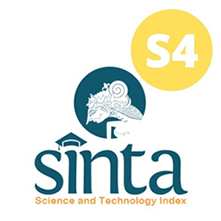The Effect of Land Surface Temperature on Dengue Hemorrhagic Fever Incidence
Abstract
Land Surface Temperature (LST) can be used to detect the occurrence of climate change. The change in LST can affect disease patterns such as Dengue Hemorrhagic Fever (DHF). The incidence of DHF in Madura from 2010-2019 showed instability. The highest DHF incidence rate in Madura occurred in 2015. This study aims to analyze the spatial and temporal effect of LST on the incidence of DHF in Madura. The analysis was carried out spatially and temporally, using multivariate regression (spatial) and Autoregression (temporal) methods with a cubic spline for LST. This study used secondary data from two institution. LST data was obtained from the MODIS NASA website, while DHF data was obtained from the East Java Provincial Health Office. LST in most sub-region, increased in 2003 and 2015, then which is in line with the incidence of dengue fever in Madura, which also increased around 2015-2016. The R2 value from the cubic spline test shows that the model used is quite good and has the same performance in all regions of Madura. The Z-value in all regions is negative, which indicates a cold area. The highest Z-value in region 1 is related to Bangkalan Regency which has more incidences of DHF in the highest category. While the lowest Z-value is found in region 3 related to Pamekasan Regency which has never been in the high category. The incidence of DHF based on LST in Madura illustrates that Bangkalan and Sumenep regencies have greater potential than Sampang and Pamekasan regencies.

This work is licensed under a Creative Commons Attribution-ShareAlike 4.0 International License.
Authors who publish with this journal agree to the following terms:
- Authors retain copyright and grant the journal right of first publication with the work simultaneously licensed under a Creative Commons Attribution License that allows others to share the work with an acknowledgement of the work's authorship and initial publication in this journal.
- Authors are able to enter into separate, additional contractual arrangements for the non-exclusive distribution of the journal's published version of the work (e.g., post it to an institutional repository or publish it in a book), with an acknowledgement of its initial publication in this journal.
- Authors are permitted and encouraged to post their work online (e.g., in institutional repositories or on their website) prior to and during the submission process, as it can lead to productive exchanges, as well as earlier and greater citation of published work (See The Effect of Open Access).











